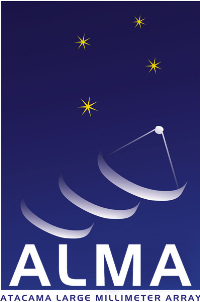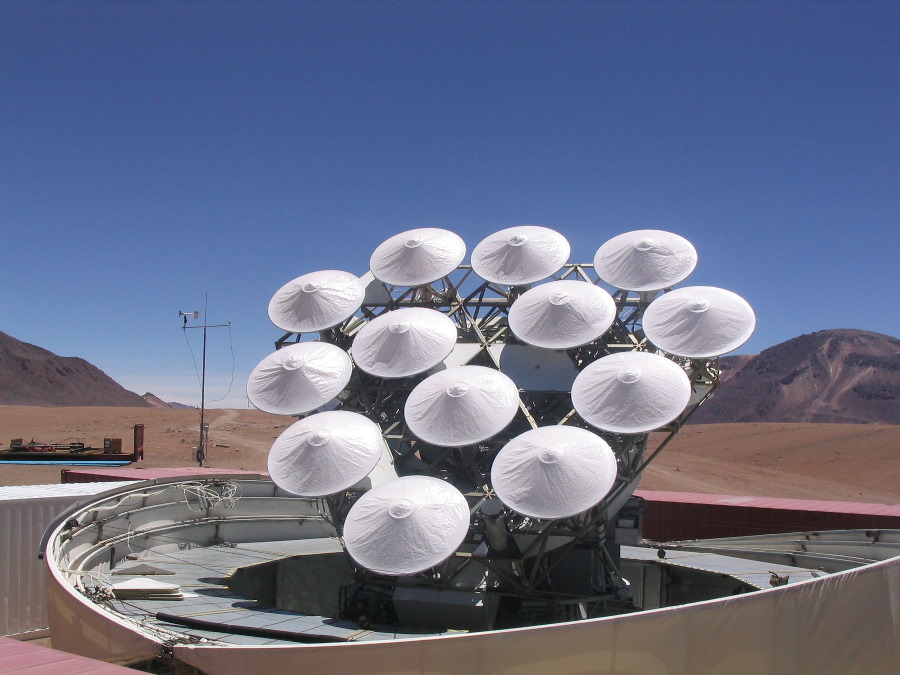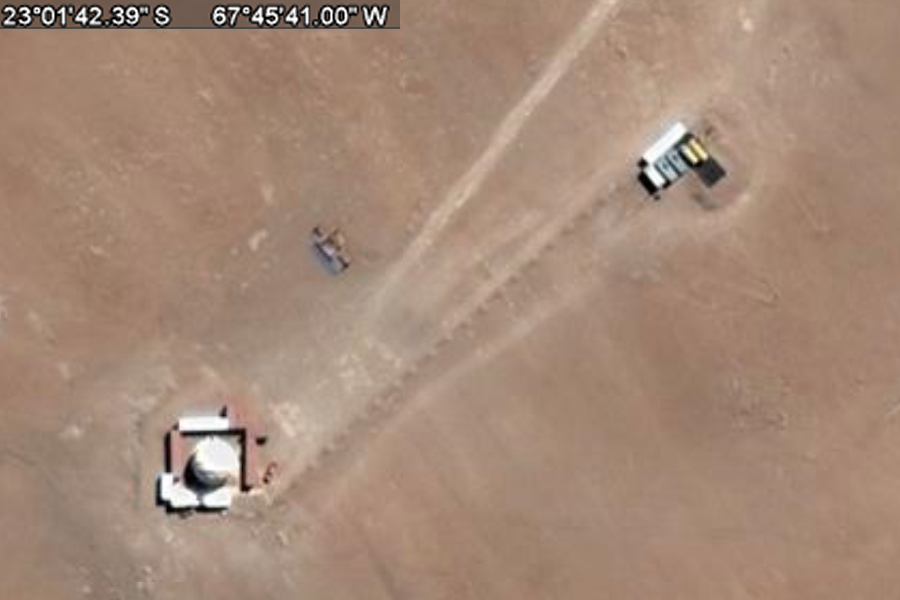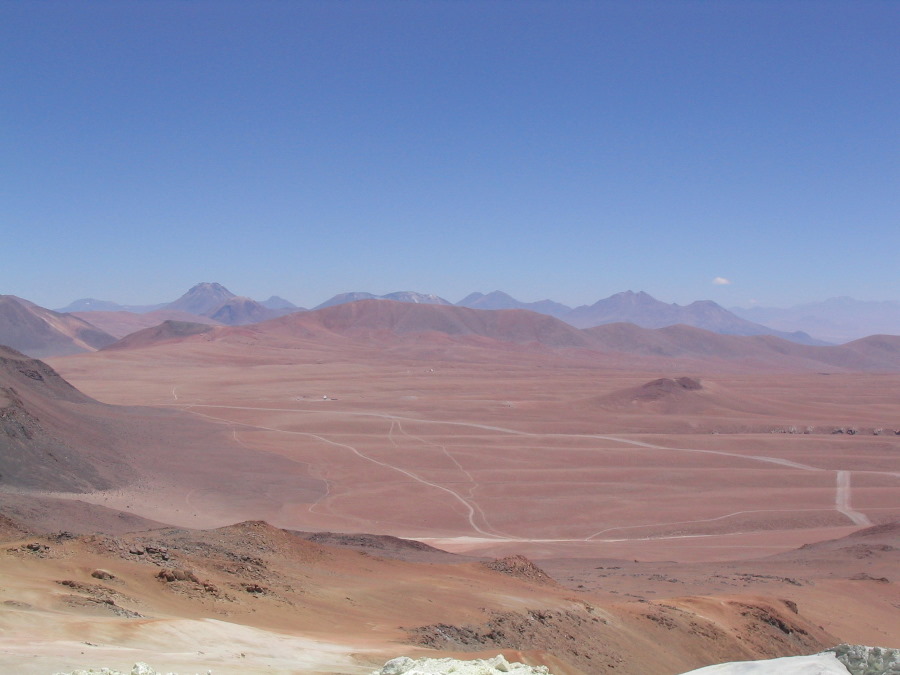Overview
The telescopes and their receivers are capable of detecting sub-millimeter and millimeter wavelengths. The array will have much higher sensitivity and higher resolution than existing sub-millimeter telescopes such as the single-dish James Clerk Maxwell Telescope or existing interferometer networks such as the Submillimeter Array or the IRAMPlateau de Bure facility. By moving the antennas at regular intervals, the resolution of the array and the size of object that can be imaged will be altered, producing a "zoom-lens" capability, similar to that employed at the VLA site in New Mexico. The high sensitivity is mainly achieved through the large numbers of telescopes that will make up the array. While sixty-four 12 metres (39 ft) dishes were originally envisaged, it is now possible that there will ultimately only be fifty built. The American and European partners have each placed orders for twenty-five antennas, with options for an additional seven. Japan is also contributing antennas in the form of the Atacama Compact Array (ACA) which will also be located at the ALMA site. By using smaller antennas than ALMA (twelve 7 m and four 12 m dishes are planned) larger fields of view can be imaged at a given frequency. The ability to move them closer together also results in the possibility to image sources of larger angular extent. The ACA will work together with ALMA in order to enhance the latter's wide-field imaging capability.
Controversy
The original plan was for the project to employ a single antenna design. The intent of testing the three prototype antennas was to compete the designs to down-select (choose the best). Three factors conspired to alter the plan:
- The size of the antenna production contract is substantial.
- It was politically expedient (or necessary) for each of the major partners to realize some non-scientific, economic return on their investment (see realpolitik).
- No arrangement was found to break up the antenna production into parts that could be parceled to the partners.
- The complexity of combining the electronic signals from different antenna designs is significantly increased.
- The overall costs of funding multiple contractors with smaller contracts increases (see Economies of Scale).
- The additional overhead of integrating different antenna designs and managing multiple contractors likely results in an overall schedule delay.
Funding
ALMA was initially a 50-50 collaboration between the European Southern Observatory (ESO) and the North American partners. The array has been extended with the help of the new Japanese, Taiwanese, Spanish and Chilean partners. ALMA is the largest and most expensive ground-based astronomical project currently under construction (current cost estimate is US$1.3 billion).
Partners
-
European Southern Observatory and the European Regional Support Center
-
National Science Foundation via the National Radio Astronomy Observatory and the North American ALMA Science Center
-
National Astronomical Observatory of Japan (NAOJ) under the National Institutes of Natural Sciences (NINS)
- ALMA-Taiwan at the Academia Sinica Institute of Astronomy & Astrophysics (ASIAA)
- Republic of Chile
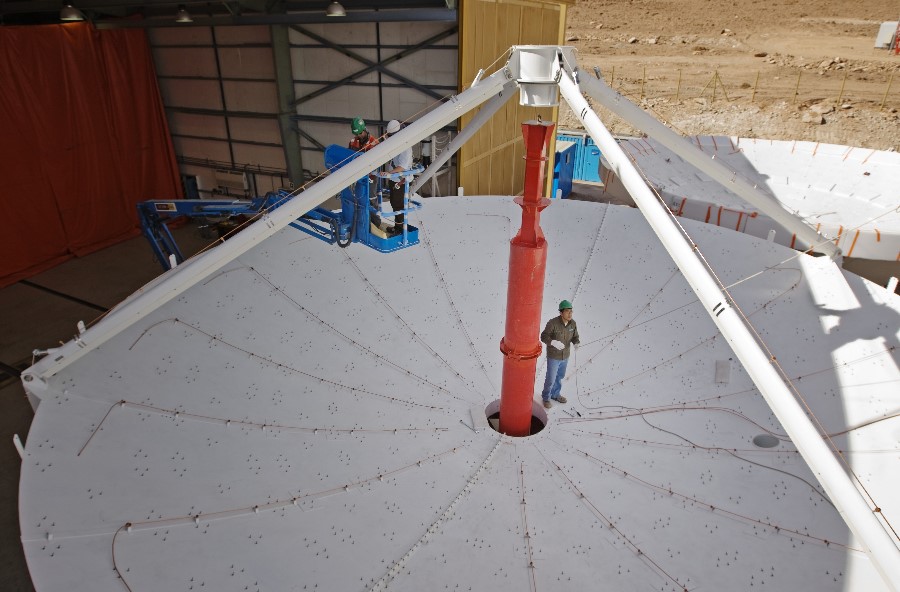 |
The complex will be built primarily by European, U.S., Japanese and Canadian companies (including General Dynamics) and universities. Three prototype antennas have undergone evaluation at the Very Large Array site in New Mexico since 2002. General Dynamics C4 Systems signed a contract with Associated Universities, Inc. to provide twenty-five to thirty-two 12m antennas. Alcatel Alenia Space, a consortium of manufacturers from France, Italy, and Germany, has been signed up to provide twenty-five of the antennas, the largest-ever European industrial contract. The first antenna will be delivered in 2007, and the rest at about one per month, finishing in 2011.
Transporting antennas to the site
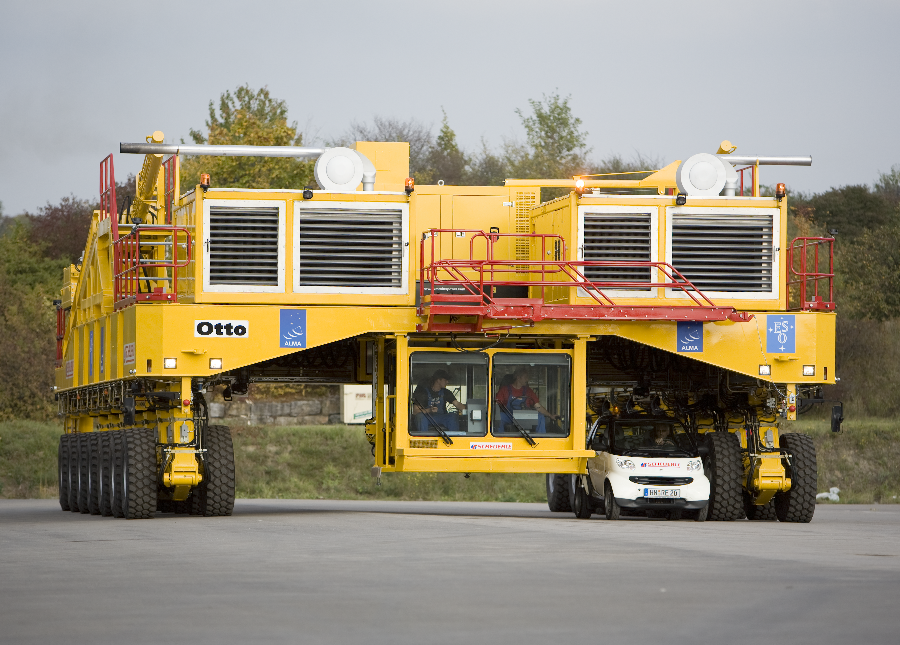 |
General information
ALMA construction and operations are led on behalf of North America by the National Radio Astronomy Observatory (NRAO). NRAO is managed by Associated Universities, Inc (AUI). ALMA construction and operations are led on behalf of Europe by ESO and Japan by the National Astronomical Observatory of Japan (NAOJ). Administration of the ALMA site in Chile is lead by ESO.
Project detail
-
50 to 64 antennas of 12 m diameter located at an elevation of 5,000 m at Llano de Chajnantor Observatory, enhanced by a compact array of 4 x 12 m and 12 x 7 m antennas (consortium currently considering to build 50 or 64
- Imaging instrument in all atmospheric windows between 350 μm and 10 mm
- Array configurations from approximately 150 m to 14 km
- Spatial resolution of 10 milliarcseconds, 10 times better than the Very Large Array (VLA) and the Hubble Space Telescope
- The ability to image sources arcminutes to degrees across at one arcsecond resolution
- Velocity resolution under 50 m/s
- Faster and more flexible imaging instrument than the Very Large Array
- Largest and most sensitive instrument in the world at millimeter and submillimeter wavelengths
Point source detection sensitivity 20 times better than the Very Large Array
| Date | Activity |
|---|---|
| May 1998 | Start of Phase 1 (Design & Development). |
| June 1999 | U.S./European Memorandum of Understanding for Design & Development. |
| February 2003 | Final North American / European Agreement, with 50% of funding from ESO, and 50% of funding shared between USA and Canada. |
| September 2004 | North American, European & Japanese draft agreement, with Japan providing new extensions to ALMA. |
| October 2004 | Opening of Joint ALMA office, Santiago, Chile. |
| October 2005 | Groundbreaking at 5000 m altitude Array Operation Site of ALMA. |
| September 2005 | Taiwan joins the ALMA Project through Japan. |
| June 2006 | N. American, European, & Japanese sign agreement on the Enhanced ALMA. |
| 2010 | Call for shared-risk early science proposals. |
| 2012 | ALMA construction complete. |
See also
- Atacama Pathfinder Experiment (APEX), single dish sub-millimeter telescope built on a modified ALMA prototype antenna
- Atacama Submillimeter Telescope Experiment
- CARMA a sensitive millimeter-wave array operated by a consortium including Caltech, University of California Berkeley, University of Illinois, University of Maryland and University of Chicago
- Cosmic Background Imager a 13 element interferometer operating in Llano de Chajnantor since 1999.
- IRAM 30 Meter Telescope (Pico Veleta, Spain), the largest millimeter telescope in the world, operated by IRAM
- James Clerk Maxwell Telescope The most sensitive existing sub-millimeter telescope
- Plateau de Bure Interferometer, one of the most successful existing millimeter-wave arrays, operated by IRAM
- List of observatories
- EU ALMA Newsletter (Jan, 2005)
- US ALMA AAAC/NSF Update (Oct, 2005)
- ALMA Partners
- GD - 2005
- ESO - 2005
- Giant truck set for sky-high task." BBC News website, 30 July 2007. Retrieved 31 July 2007.
- July 2008 NRAO ALMA newsletter article by Dr. Al Wootten
- Official site
- Official NRAO ALMA site
- Official UK site
- Official ESO site
- Official NAOJ site
- Official Chilean ALMA site
- Webcam showing array construction work at the Operations Support Facility further down the mountain
- NRAO ALMA site
- UK ALMA site
- ESO ALMA site
- 'Alma' sets new heights for astronomy, BBC News, 7 August 2006.
- Huge Observatory in Andes Takes Shape, Space.com, 7 February 2009.
- Podcast Interview with the European ALMA Instrument Scientist Robert Laing
- Llano de Chajnantor Observatory - Wikipedia
